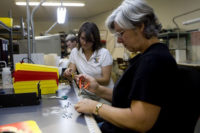Large and small manufacturers have developed a wide array of sustainability initiatives. In fact, more than one-half (56 percent) of respondents in ASSEMBLY Magazine’s 2014 State of the Profession study claim their plant has implemented green-related programs during the past 12 months. That’s a 3 percentage point increase over 2013 and 8 percentage points higher than 2012.
Large manufacturers (companies with 1,000 or more employees) are more likely to be involved with green initiatives. For example, 73 percent of assemblers in that category have implemented sustainability programs during the last 12 months. On the other hand, only 19 percent of small manufacturers (companies with fewer than 50 employees) have gone green.
Green manufacturing initiatives are most common in the transportation equipment sector, where nearly two-thirds (64 percent) of assemblers work in plants that have implemented environmental programs.
Assembly professionals in the electrical equipment and appliance manufacturing (58 percent), contract manufacturing (56 percent), energy manufacturing (55 percent), and plastic and rubber products (55 percent) industries are also actively engaged in various types of green initiatives.
Manufacturers are pursuing initiatives such as energy-efficient lighting, landfill gas, recycling, solar panels and wind turbines. For instance, Chrysler’s Belvidere Assembly Plant recently installed a cascade air system, which involves reusing heated air in more than one location in the plant. Rather than using natural gas to continually heat cold outside air to a comfortable working temperature, the plant supplements cold outside air with warm plant air, using less natural gas for heating.
Honda Transmission Mfg. of America Inc. recently installed a pair of wind turbines at its plant in Russells Point, OH. Combined output from the turbines is 10,000-megawatt hours per year, which is used to provide 10 percent of the plant’s electricity.
Three-quarters (75 percent) of State of the Profession respondents claim their assembly plant has implemented a paper and plastic recycling program, which is 4 percentage points higher than in 2013.
Other common green initiatives include energy-efficient lighting (67 percent), reusable shipping containers (60 percent), energy-efficient heating, ventilating and air conditioning systems (27 percent), and wastewater treatment (24 percent). Solar panels (8 percent) and wind turbines (3 percent) are less common in manufacturing.
Small manufacturers (companies with less than 50 employees) are more likely to engage in more basic sustainability programs, such as paper and plastic recycling (57 percent) and energy-efficient lighting (45 percent). However, they are less willing to invest in more expensive initiatives, such as solar panels (3 percent).
On the other hand, manufacturers with more than 2,000 employees are more likely to be involved in wastewater treatment (42 percent), solar panels (33 percent) and wind turbines (17 percent).
There’s also some regional differences when it comes to green initiatives. For instance, manufacturers in the South (12 percent) and West (10 percent) are more likely to invest in solar panels than manufacturers in the Midwest (6 percent) and Northeast (2 percent). However, manufacturers in the Northeast (40 percent) are more involved in wastewater treatment systems vs. manufacturers in the West (15 percent).






